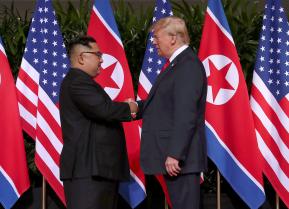Meet the 'New' F-21 Fighter: An F-16 On Steroids (With F-22 and F-35 DNA)?
Is this the fighter India needs?
Lockheed Martin in mid-February 2019 offered to sell India a new fighter the company calls the "F-21."
Only it doesn't look like a new fighter at all. The F-21 looks like an F-16.
In fact, the F-21 is an F-16 that Lockheed has upgraded with new cockpit displays, conformal fuel tanks, a larger airframe spine that can accommodate additional electronics, fittings for towed radar decoys, a new infrared sensor and a refueling probe that's compatible with India's Russian-made aerial tankers.
"The F-21 addresses the Indian air force’s unique requirements," Lockheed stated.
The rebranding raises an important question. At what point do upgrades transform an old fighter into a new fighter?
It isn't a purely academic question. The number of different fighter types that a country simultaneously can produce is a useful marker of that country's war-making capacity.
India for years has been struggling to replace a large fleet of old, Russian-made warplanes. In 2018 the Indian air force operated 244 1960s-vintage MiG-21s and 84 MiG-27s that are only slightly younger.
The MiG-21s, in particular, are accident-prone. Since the first of 874 MiG-21s entered Indian service in 1963, around 490 have crashed, killing around 200 pilots.
New Delhi wants to spend around $18 billion building 115 new fighters to replace the old MiGs. The new planes would fly alongside European-designed Jaguars, French Mirage 2000s and Rafales, Russian MiG-29s and Su-30s, and India's own indigenous Tejas fighter in what Lockheed described as "the world’s largest fighter aircraft ecosystem."
Competitors for the 115-plane purchase include the F-21, Boeing's F/A-18E/F, the Rafale, the European Typhoon, the Swedish Gripen E and the Russian MiG-35 and Su-35. Indian companies would assemble the new jets on license.
Lockheed initially implied India could follow an acquisition of F-21s with a separate purchase of the company's F-35 stealth fighters.
"The F-21 has common components and learning from Lockheed Martin’s fifth-generation F-22 and F-35 and will share a common supply chain on a variety of components," Lockheed stated on its website on the morning of Feb. 20, 2019.
A few hours later, that claim disappeared from the site.
For the purposes of Lockheed's marketing campaign, the F-21 is a new fighter, although it shares many of its major features with the F-16V the company has sold to Bahrain, Greece, Slovakia, South Korea and Taiwan. Lockheed can build new F-16Vs or upgrade older F-16s to the V-standard.
Still, renaming the F-16V isn't only semantic. An F-16V or F-21 is a radically different warplane compared to the F-16A that first flew in 1978. The F-16A is a nimble, eight-ton fighter with an unsophisticated radar and short-range weapons. The F-16V weighs 10 tons, boasts a cutting-edge radar and other sensors and carries a wide array of long-range weaponry, all at the cost of maneuverability.
The only thing an F-16A and an F-16V have in common to any meaningful degree is their basic shape. So why not call the F-16V something different?
U.S. officials at one time deliberately stuck with an old designation for a new plane, all in an effort to make a program seem less risky than it actually was.
After canceling several fighter programs on cost grounds in the early 1990s, the U.S. Navy tapped Boeing to develop a new fighter with the same basic shape as the existing F/A-18, but with a larger fuselage and wing and more powerful engines and sensors.
The Navy called the new plane the "F/A-18E/F." But in every way that mattered, it was a new fighter with different capabilities than the original F/A-18 possessed.
Likewise, the Pentagon acquired three separate stealth fighters with the F-35 designation -- the land-based F-35A, the vertically-landing F-35B and the carrier-based F-35C.
The three F-35 "variants" share very few design elements outside of their cockpits. Lt. Gen. Christopher Bogdan, then the head of the F-35 program office, in 2016 told a seminar audience that the F-35 models are only 20- to 25-percent common.
The danger in not giving a new fighter a new designation is in the impression it creates. In early 2019 China manufactured several fighter types with the basic airframe of the Russian Su-27. Each type has a unique designation. J-11. J-15. J-16.
Add in other fighter types that China was developing at the same time and it would be accurate to say that the country simultaneously made a dozen different fighters for domestic and foreign markets.
By contrast, the United States appeared to make fewer fighter types. After all, as of early 2019 only the F-15, F-16, F/A-18 and F-35 were in production at American factories. And three of the types first appeared in the 1970s or 1980s.
The American tendency to cling to old designations created that false impression. In reality, U.S. companies in early 2019 produced at least six modern fighters types.
They include an advanced F-15 variant that Boeing offered to the U.S. Air Force as the "F-15X" and a new F/A-18E/F model that has almost nothing in common with Boeing's 1980s-vintage F/A-18A/B.
Lockheed meanwhile made three kinds of F-35 plus the F-16V. Or "F-21," if you will.
New Delhi could select its new fighter in 2019. If it picks the F-21 and opts to keep Lockheed's designation for the type, it rightfully could claim to be the first operator of a brand-new fighter.
Even if that fighter appears to the casual observer to be just another old F-16.
David Axe serves as Defense Editor of the National Interest. He is the author of the graphic novels War Fix, War Is Boring and Machete Squad.


